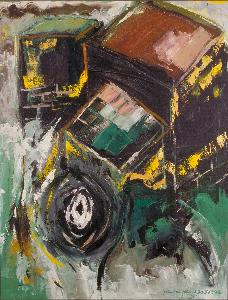Mohammad Din Mohammad
Mhd Din;Mohammad Din Mohammad
Place: Kampung Gangsa
Born: 1955
Death: 2007
Biography:
Mohammad Din Mohammad was a Singaporean Malay artist, born in 1955 in Malacca, Malaysia. He is known for his works inspired by Sufism, which is a mystical form of Islam that emphasizes the inner dimension of faith. His artistic practice spanned painting, assemblage, and Islamic calligraphy, reflecting his deep devotion to both art and spirituality.
Artistic Background
Mohammad Din Mohammad studied art at the Nanyang Academy of Fine Arts in Singapore, majoring in Western painting from 1973 to 1976. During this period, he was exposed to various artistic styles and techniques that influenced his unique blend of Western ideas with his cultural background. His works are also deeply rooted in Sufi mysticism, which he practiced throughout his life. Key aspects of his artistic style include the use of symbols and icons to convey his ideas and Islamic philosophies. He often incorporated calligraphic rendering into his oeuvres, which served as his signature among his works that included sculpture, installation, and abstraction.
Notable Works
Some of his notable works include Mohammad Din Mohammad: Burning Desire Four, a painting that showcases his unique blend of cultural influences and mystical themes. Another notable work is Kaa, a large acrylic on canvas painting created in 1994, now housed at the National Museum of Singapore.
Artistic Influences
Mohammad Din Mohammad's artistic style was influenced by various factors, including his cultural background and his practice of Sufi mysticism. He was also influenced by his devotion to the Malay martial arts called silat, which he practiced throughout his life.
- His use of symbols and icons to convey his ideas and Islamic philosophies
- Incorporation of calligraphic rendering into his oeuvres
- Influence of Sufi mysticism on his artistic style
- Devotion to the Malay martial arts called silat
Legacy
Mohammad Din Mohammad's legacy as an artist and a Sufi mystic continues to inspire art lovers and collectors. His works can be found in various museums and collections, including the National Museum of Singapore. For more information about his life and works, visit Mohammad Din Mohammad's page on Wikioo.org or check out the Wikipedia article about him. You can also explore his artworks and learn more about his artistic style by visiting the National Museum of Singapore website, which features a collection of his works. Additionally, you can find more information about Sufism and its influence on art by visiting the Wikioo.org article on A Journey Through Art History.



